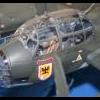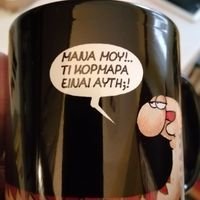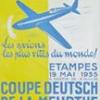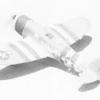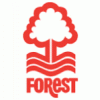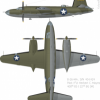Search the Community
Showing results for tags 'FW-190'.
-
OK Guys, The Hasegawa 1/32 Fw-190 A5 will be my entrance for this GB. I have got some goodies with it as well. There are two resin gun pods from Eagle cals for under the wing. This is the rüstsats U12. With this I also have the decals from eagle cals with one of the schemes for Lt.Erich Hondt's Fw-190 A5/U12 from 2/.JG11. Here are some pictures of the model and goodies. the Box. And the goodies with it. Here are the underwing gondola's with it's manual. And the decalsheet that is needed for it. This is the scheme I will use. Now we need to wait for a week before it starts. I still need to finish two Ju-88's and a Yak 3. Luckely I managed to finish my Saab Draken yesterday. So that one is now out of the way. Cheers,
-
Heelo, I have bought a correction set for Revell's 1/72 Fw-190A-8 (Quickboost set No. 72161) I have compared it to the kit forward cowling ring (which has received some criticism for its shape), and there is no discernible difference (?) Even the radius of the opening is almost the same (the difference is less than 0.5mm) Img Source: Quickboost So, given that there is no difference between the two (visible to the naked eye), my question is - what does this replacement actually correct?
-
Hi folks, after few galleries I decided to start my first build report here. I am going to build Eduard's Weekend Fw-190 A-8 using Karaya correction and upgrade kit. Karaya kit is rich of parts, both PE and (mainly) resin: And work in progress...
-
Focke Wulf Fw190D-13 1:48 Hobbyboss History Arguably one of the best fighters of the time, the Fw 190 was widely used during the Second World War. A total of over 20,000 were produced, including some 6,000 fighter-bomber variants. The 190 remained in production from 1941 until the end of the war, going through multiple redesigns. The Fw.190 made a name for itself as a true Luftwaffe workhorse and was used in a wide variety of roles, including a high-altitude interceptor (especially the Fw.190D), escort fighter, fighter-bomber and night fighter. When the Fw 190 started flying operationally over France in August 1941, it quickly proved itself to be superior in all but turn radius to the Royal Air Force's main front-line fighter, the Spitfire Mk. V. The 190 wrested air superiority away from the RAF until the introduction of the vastly improved Spitfire Mk. IX in July 1942 restored qualitative parity. The Fw 190 made its air combat debut on the Eastern Front in November/December 1942; though Soviet pilots considered the Bf 109 the greater threat, the Fw 190 made a significant impact. The fighter and its pilots proved just as capable as the Bf 109 in aerial combat, and in the opinion of German pilots who flew both, provided increased firepower and manoeuvrability at low to medium altitude. The Fw 190 became the backbone of the Jagdwaffe, along with the Bf 109. On the Eastern Front, and was versatile enough to use in Schlachtgeschwader (Battle Wings or Strike Wings), specialised ground attack units which achieved much success against Soviet ground forces. As an interceptor, the Fw 190 underwent improvements to make it effective at high altitude, enabling it to maintain relatively equal with its Allied opponents. The Fw 190A series performance decreased at high altitudes (usually 6,000 m (20,000 ft) and above), which reduced its effectiveness as a high-altitude interceptor, but this problem was mostly rectified in later models, particularly in the Junkers Jumo 213 inline-engine Focke Wulf Fw 190D series, which was introduced in September 1944. In spite of its successes, it never entirely replaced the Bf 109. The version this kit depicts, is that of the D-13 which was based on a D-11, Fitted with the up-rated Jumo 213F series engine similar to the Jumo 213E used in the Ta-152 H series but minus the intercooler. Two 30 mm (1.18 in) MK 108 cannons were installed in the outer wings to complement the 20 mm MG 151s in the inboard positions, but also fitted with a MG151/20 20mm cannon firing through the propeller hub. The Model This kit is the sixth Fw-190 released by Hobbyboss, and is based on the original D-9, released in 2013. The kit come ins a smallish, but quite well filled box, with an artists impression of a D-13 parked up at an airfield, which has obviously been captured, as the hapless pilot is being led away by a British soldier. Inside, there are eight sprues of various sizes, all in a light grey styrene, one sprue of clear styrene, a small sheet of etched brass, plus the decal sheet. As usual for a Hobbyboss kit, all the parts are well moulded, with no sign of flash or other imperfections, and only a few moulding pips. The instructions are very clearly printed and easy to follow, there being only eight steps to completion. Construction naturally begins with the cockpit and the fitting of the front and rear bulkheads to the single piece floor pan, complete with side consoles. Also fitted to the floor is the rudder bar, with its separate foot pedals attached, the joystick, lower instrument panel, with decal instruments, along with the seat and its supporting frame. The supercharger is then assembled, consisting of five parts it is then attached to the engine fire wall, along with the two piece oil tank. The exhaust stubs are fitted to each fuselage half from the inside before the firewall bulkhead, cockpit assembly, upper instrument panel, also with decal instruments, and four piece tail wheel assembly are sandwiched between the two fuselage halves. It is at thsi point when you realise that you not be able to see anything of the supercharger detail. The closed up fuselage is then fitted with the top forward decking complete with separate air intake, gunsight, PE rear canopy decking, horizontal tailplanes and rudder. The windscreen is then glued into position and the canopy, fitted with the pilots head armour and support, plus the three piece slider assembly, is also fitted. The main undercarriage bays are then glued to the single piece lower wing, the bays having been detailed with wing mounted cannon, plus centre and outboard cross braces. If the model is to be fitted with the various bomb racks, the holes of these will need to be opened up before the upper wing panels are attached. The trailing edge is fitted with separate flaps and ailerons, the wing tips fitted with clear navigation lights and the starboard wing tip with the pitot probe. There is a choice of cowling, one with closed gills and one with open gills, to be fitted to the nose of the fuselage. The wing assembly is then fitted to the fuselage assembly and it starting to look like an aircraft. Each main undercarriage is made up from a single piece oleo, bay door and wheel. Each undercarriage is then glued into position and fitted with a retraction actuator and spring unit. Whilst the model is upside down for undercarriage fitment, three aerials and the footstep are attached. The big fat prop is fitted with the separate backplate and spinner, before being fitted to the model, along with the large four piece intake scoop that is fitted to the starboard side of the forward fuselage. The model can be fitted with two bombs outboard of each undercarriage leg each bomb is fitted with two crutch pads and fitted to a pylon. On the centreline you can fit a quad bomb carrier. Made up from four bombs, again each fitted with two crutch pads, a four point stores carrier, with another pair of crutch pads and the long pylon. Decals Along with the instrument panels, the decal sheet carries national markings and unit markings for just one aircraft, that of Fw-190D-13, Yellow 10, W.Nr.836017, as used by Stab JG 26, based at Flensburg airfield. The decals are well printed with minimal carrier film. Ehy are slightly glossy, with good opacity and in register. There is a full set of stencils included, whilst the swastika has been printed in two halves, to get round the laws in some European countries. Conclusion This whole series of Fw-190s by Hobbyboss have been great little kits, maybe not as complicated, or some would say accurate as the Eduard offerings, but a nice kit none-the-less. Yes it’s a fairly simple kit, which can be a good thing if you’re trying to break modellers block, and also be a good kit to practice painting German mottle scheme for that bigger, more expensive kit you have in the stash. Highly recommended. Review sample courtesy of
-
My first completed build in 2016, another Focke Wulf Fw-190 from Eduard's Profi Pack. Added photo etch landing gear covers from Eduard Set and decals from Aeromaster (Butcher Birds #72001). Photo of the original aircraft here: http://www.jg300.de/fw-190a-gelbe-1-7-oder-17.html Gun barrels from Master Model. Painted with acrylics from Gunze/Mr.Hobby. Photographs: Wolfgang Rabel, IGM Cars & Bikes Cheers!
- 16 replies
-
- 23
-

-
- Eduard
- Focke-Wulf
-
(and 6 more)
Tagged with:
-
Hello, here's my Eduard Fw-190 A8 finished. Work in progress: http://www.britmodeller.com/forums/index.php?/topic/234991920-building-the-172-eduard-focke-wulf-fw-190-a8/ Landing gear doors are photo etch pieces from Brengun (intended for the Airfix kit). Gun barrels & pitot tube from Master Model. Painted with Gunze acrylics according to instructions. Thanks for looking. Greetings from Vienna Roman
-
Hi guys, Arrived home earlier today to a nice package from Eduard that contains the new release of the 1/72 fw-190. Here are couple of pictures that I took with my cellphone tonight for a preview. Some of the Czech guys have been working on theirs already, and their work can be seen here: http://modelforum.cz/viewtopic.php?f=57&t=97364 From their observations, it seems like the kit has a tight fit, and the addition of PE parts in the cockpit appears to make them bit too thick. Also there has been a lively discussion about the covers of the outer guns, namely that there is a missing small panel covering the ejection channel for 30mm ammo when not installed, and the presence of the bulges on the upper side. Finally, Eduard has already released several AM sets both in PE and resin, and more have been announced. From the construction of the kit, it seems that there might be one with the interior of the rear fuselage coming as well...or at least the grove will make it easier to separate and open the large inspection panel on the left side of the fuselage. Onto the photos, I let you be the judge of the efforts: Here are the decals... ...and the PE parts The fuselage halves with some nice rivet detail Inside of the left fuselage half And the wings And some of the smaller parts; the face of the BMW engine seems rather simplistic, but likely not much will be seen past the propeller and the fan This is the only fw-190 in 1/72 that has the back wheel well wall done as the spar rather than molded into the bottom wing The clear parts look crisp, without blemish, and nicely thin
-
Focke Wulf Fw-190F8 detail sets Eduard 1:32 Eduard appear to be covering all the bases with their aftermarket detail sets for the Revell 1:32 Fw-190F8. First, you have the wonderful resin cockpit, machine gun bay, wheels and undercarriage legs, now they have released four etched sets and a set of masks. The etched parts are for the interior, seatbelts, flaps and a smaller zoom set for the cockpit. At least the modeller can’t say they don’t have a choice of what to use on his model, or how much they want to add. Interior Set (32842) The parts are contained on two sheets of relief etched brass of roughly equal size, with one being unpainted and the other not only pre-painted but self adhesive as well. The unpainted sheet contains items such as the fittings for the gunsight and the coaming that surrounds it, the rear bulkhead seat rails and fixings, and seat fittings. The canopy slide panel is fitted with a replacement upper face and access panel, map case and strap, joystick cable, side wall stringers/longerons, and canopy fixtures. The pre-painted sheet contains the upper and lower instrument panels, replacing the moulded on dials, complete with the instrument faces on the backplate. A little dab of aqua clear will give them the appearance of glass fronts. The sheet also contains the myriad of coloured levers, knobs, side consoles, new throttle quadrant, switch clusters, trim wheel, and rudder pedal plates,. Flap Set (32372). To use this set the kit details have to be removed first, both from the flap bays and the trailing edges of the wing where the flaps join. The interior of the flap bays have their ribs joined at the tip and will require carful bending to enable the modeller to glue them in place. With the bays positioned the inner face of the flaps are also carefully folded around the leading edge so that they match the profile diagram in the instructions. The leading edge is then fitted with the provided hinge plates with the curved leading edge plates between them. The trailing edge of the flap bays are then detailed with the opposing hinges, into which the flap is slid into position. The result is a pair of very nicely detailed, and accurate flaps. Interior Zoom Set (33149) This zoom set contains only the above pre-painted sheet and allows the modeller to build a well detailed cockpit without the hassle of getting bogged down with detail that might otherwise be deemed superfluous. Seatbelts (32843) This small single sheet set contains a complete and comprehensive set of seat belts, buckles and clasps. The belts really are rather fiddly to assemble, but will look great when fitted. The seat belts are pre-painted so no need for some fiddly painting, just a slightly darker wash to tone them down a bit. Masks (JX181) To complement the sets mentioned above, Eduard have also released a set of paint masks for the Fw-190, which helps masking the clear areas a whole lot easier particularly as there is a quite a lot of clear styrene edges on the rear canopy. As usual they don't provide the whole canopy, just the edges, the rest you will need to cover yourself. Conclusion There’s never a kit release without Eduard set of two being designed for it as they are so prolific. Whilst not as comprehensive as some of the previous releases, but then they have released all that resin stuff, they will add that extra level of detail sought by some modellers. The flap set looks to be particularly good and really will make the model stand out from the crowd. It is still disappointing that they chose to release the seatbelt set separate from what is basically an interior set, but I guess it gives modeller more choice on how much they want to add. The instructions aren’t the clearest, so care will need to be taken when adding the parts. The masks are always useful though. Highly recommended. Review sample courtesy of
-
Seatbelt and Mask sets for Revell Fw-190 1:32 HGW Each of these two sets are for the new 1:32 Fw-190F8 from Revell. The smaller of the sets contains just the seatbelts, whilst the large contains the seatbelts and a set of masks for the canopy, on in this case canopies, as there is a choice of two within the kit. This will probably be the most popular set. The laser cut belts are remarkably beautifully cut, with no ragged edges to worry about. Being laser cut, you are left with just a small join between the belts and the fret. With each part removed, it’s just a matter of threading through the etched parts and gluing the joints over. The belts are ready to fit, complete with markings and placards, to the seat and cockpit and there is a nice clear diagram showing the positioning, although you may wish to refer to actual photographs to get the correct level of sag. The masks also appear to be laser cut and there appears to be a little bit of shrinkage, which hopefully has been taken into account with regards to fit and coverage. The instructions clearly show which masks go where and for which canopy. Unlike most over mask sets HGW have included masks for both the interior and exterior making it a whole lot easier to airbrush the appropriate colours. Conclusion HGW have released two very useful sets although I imagine that the mask set will be the most popular. That said, it’s always good to have a choice and for those modeller who either don’t like or don’t need masks then they can just use the super seatbelts. Very highly recommended. Review samples courtesy of
-
Focke Wulf 190 Cockpit and MG 131 compartment 1:32 Brassin Having just finished reviewing the last two sets from Brassin, HERE, a further two sets arrived from Britmodeller HQ. The first is a comprehensive set to replace the kit cockpit and the second is to replace and detail the upper gun mounts between the cockpit and engine bay. (Cockpit Set 632-056) This set is provided in the small cardboard box now standard for the larger Brassin sets. On opening and removing the top layer of foam, the modeller is confronted with a large resin part, three bags of smaller parts in both dark and light grey resin plus a bag of three etched brass sheets, a small sheet of acetate and a small decal sheet. The single large resin part completely replaces the kits cockpit tub. This will need to be carefully removed from the moulding blocks and have the thinned resin panel behind the seat cut away. The complex seatbelt assemblies are built up from the pre-painted etch sheet and fitted to the seat once the squab and back rest have been added, which is then fitted to the tub, along with the joystick, a small instrument panel between the rudder pedals, and an access panel just behind the seat, (there are two styles of panel to choose from). The rudder pedals are next and these are made up from both resin and etched parts, followed by the lower instrument panel complete with undercarriage lever, rocket and MG FF cannon controllers and a number of other levers, and finally the two piece throttle lever. Before the cockpit can be fitted to the kit fuselage the set adds a three part canopy opening handle, replacement coaming, upper instrument panel, with each instrument provided on the decal sheet and two styles of very intricate gun-sights. The windscreen framing is then added to the kit part, whilst the armoured head rest is fitted to the new canopy decking and fitted with one of two styles of armour support, as both the open and close styles are provided, along with the slide for the canopy movement, all fitted to the inside of the canopy. MG 131 Mount 632-060. This set comes in the more normal blister pack and contains both dark and light resin parts and a sheet of etched brass. Before doing anything, you will have to remove all the moulded detail off the lower front bulkhead. The replacement bulkhead is made up of a brass panel, to which the various strengtheners and fittings are added. The two resin ammunition tanks are then fitted to the bulkhead hangers. The upper kit decking is completely replaced by a beautifully moulded resin part, to which the replacement MG 131 machine guns are fitted. One of the sets barrels was slightly bent, so some careful manipulation may be required on yours, using some warm water. The ammunition tracks are then attached followed by a PE framework/pipework that sits around the windscreen, the six panel fixings, three per side and the large resin access panel. Conclusion Although the new Revell kit has superb detail straight out of the box some modellers are just not content. These sets will certainly scratch that itch with a level of detail that injection moulding cannot, certainly at the price point Revell try to aim at. So if you want as much detail as you can get in your completed model these sets are for you. Highly recommended. Review sample courtesy of
-
Focke Wulf Fw-190F8 Revell 1:32 The Focke-Wulf Fw 190 Würger (English: Shrike) is a German single-seat, single-engine fighter aircraft designed by Kurt Tank in the late 1930s and widely used during World War II. Along with its well-known counterpart, the Messerschmitt Bf 109, the Fw 190 became the backbone of the Luftwaffe's Jagdwaffe (Fighter Force). The twin-row BMW 801 radial engine that powered most operational versions enabled the Fw 190 to lift larger loads than the Bf 109, allowing its use as a day fighter, fighter-bomber, ground-attack aircraft and, to a lesser degree, night fighter. The Fw 190A started flying operationally over France in August 1941, and quickly proved superior in all but turn radius to the Royal Air Force's main front-line fighter, the Spitfire Mk. V, especially at low and medium altitudes. The 190 maintained superiority over Allied fighters until the introduction of the improved Spitfire Mk. IX in July 1942. In November/December 1942, the Fw 190 made its air combat debut on the Eastern Front, finding much success in the specialised ground attack units called Schlachtgeschwader (Battle Wings or Strike Wings) from October 1943 onwards, following the redesignation of all former Sturzkampfgeschwader dive-bomber wings at that time. Though Soviet pilots considered the Bf 109 the greater threat, the Fw 190 and its pilots proved just as capable as the "lean" (to VVS pilots) inverted V-12 inline-powered Messerschmitt in aerial combat. In the opinion of German pilots who flew both, the Fw 190 provided increased firepower and manoeuvrability at low to medium altitude. Still, it never entirely replaced the Bf 109. The Fw 190A series' performance decreased at high altitudes (usually 6,000 m (20,000 ft) and above), which reduced its effectiveness as a high-altitude interceptor, but this problem was mostly rectified in later models, particularly in the Junkers Jumo 213 inline-engine Focke-Wulf Fw 190D series, which was introduced in September 1944 and restored relative parity with Allied opponents. The subject of this kit is that of the F8 variant which was basically an A-8 model re-designated, having a slightly modified injector on the compressor which allowed for increased performance at lower altitudes for several minutes. Armament of the Fw 190 F-8 was two 20 mm MG 151/20 cannon in the wing roots and two 13 mm (.51 in) MG 131 machine guns above the engine. Fw 190 F-8/U1 - long range JaBo, fitted with underwing V.Mtt-Schloß shackles to hold two 300 L (80 US gal) fuel tanks. ETC 503 bomb racks were also fitted, allowing the Fw 190 F-8/U1 to carry one SC 250 bomb under each wing and one SC 250 bomb on the centreline. Fw 190 F-8/U2 - torpedo bomber was fitted with an ETC 503 bomb rack under each wing and a centre-line mounted ETC 504. The U2 was also equipped with the TSA 2 A weapons sighting system that improved the U2's ability to attack seaborne targets with a 700 kg (1,500 lb) BT 700. Fw 190 F-8/U3 - heavy torpedo bomber was outfitted with an ETC 502, which allowed it to carry one BT-1400 heavy torpedo (1,400 kg (3,100 lb)). Owing to the size of the torpedo, the U3's tail gear needed to be lengthened. The U3 also was fitted with the 2,000 PS BMW 801S engine, and the tail from the Ta 152. Fw 190 F-8/U4 - created as a night fighter, was equipped with flame dampers on the exhaust and various electrical systems such as the FuG 101 radio altimeter, the PKS 12 automatic pilot, and the TSA 2 A sighting system. Weapons fitted ranged from torpedoes to bombs, however, the U4 was fitted with only two MG 151/20 cannon as fixed armament. The Model This completely new moulding came as bit of a surprise, but very welcome none the less. The quite large, and unfortunately end opening box is pretty much full of styrene. Each of the eight blue-grey sprues are very nicely moulded, with little or no sign of flash and not too many moulding pips, although some of the them and the sprue gates are quite large. There are quite a few flow marks visible on a lot of the parts, but these shouldn’t cause too many problems under a coat of primer. Details are finely produced with neat panel lines and other fixtures and fittings. Throughout the kit there are lots of details, particularly the engine and cockpit, which means it can be made pretty much out of the box with perhaps the exception of some replacement seatbelts. Construction starts with the modeller having to decide which version of the two provided that they wish to make. Since each version requires having different hole opened up from the inside of the lower wing depending on whether the single SC500 centreline bomb and two wing drop tanks or the single SC250 on the centreline and the two pairs of SC50s are going to be fitted. There are also two larger holes that require to be opened up should you wish to use the large stand that is provided in the kit. Actual assembly begins in the single piece cockpit tub with the fitting of the joystick, rudder bar and footplates. These are followed by the lower instrument panel, seat, with separate squab, plus the decal lap and shoulder straps. The main instrument panel is then fitted with the revi gunsight and its two clear screens the gunsight is then carefully slid thought the gap in the coaming and the panel glued into place. For the instruments on the upper and lower panels Revell have provided a some nicely printed decals, but in this scale it may be better to use some separate instruments and bezels from the likes of Airscale. At this point, several sub-assemblies are constructed. These include the forward upper gun mounting deck consisting of two parts, the tailwheel is made up of two halves for the tyres plus the inner and outer hubs, which is then slid onto the axle of the oleo and enclosed with the port side of the mounting yoke. Once the insides of the fuselage have been painted there are a couple of parts fitted to the fuselage sides, before the instrument panel/coaming are glued to one half, as is the tail wheel, (in either retracted or extended position), before the fuselage can be closed up. The completed cockpit assembly is then fitted from beneath and the forward gun mount fitted just in front of the coaming. Moving onto the wings the two inboard cannon barrels are attached tot eh main wing spar along with the centre section of the main undercarriage bay. The assembly is then glued into position, with the spar aft of the main wheel bays. Behind the main spar there is another plate which moulded with the two rear spars, whilst the main wheel bays are fitted ahead of the main spar, covering the openings. The two ammunition canisters for the upper machine guns are then fitted to the main spar panel, along with the engine bearers and the engine mounting ring before the whole assembly is attached to the underside of the fuselage. The two part ailerons are then assembled and fitted to the upper wing panels, which are then attached to the lower panel. The optionally positioned flaps are then fitted. Each of the horizontal stabilisers, elevators and rudder are made up of two halves, which when all assembled are glued into position. Probably the most complex assembly of the kit has to be the engine. Each of the two banks of cylinders is made up of two parts, but where the moulding differs here is that the cylinder heads are moulded complete and the rest of the cylinders are on a smaller inner section, thus elevating any awkward seams to worry about. With the banks assembled the two sets of push rods are attached and the banks joined together via a spacer ring. The inlet manifold is then fitted from the rear, followed the exhaust manifolds, the prop shaft and the auxiliary gear box. The completed engine is then attached to the previously assembled engine mount, followed by the two small lower panels and the front cowling ring. The main undercarriage units each consist of the main oleo, with separate scissor link, five part wheels, (two tyre halves, inner and outer hubs and outer cap), and the undercarriage door. The undercarriage assemblies are then glued into position, followed by the retraction jacks. If the undercarriage is to be posed retracted then there are separate wheel parts to be used. With the undercarriage attached, the kit is turned over and the windscreen is fitted followed by the upper and lower cowling covers, again with optional parts for them to be posed open or closed. On the upper decking the machine gun breeches and barrels are fitted and the area is finished off with the cowling side panels and the large machine gun panel. The kit comes with optional canopies, early and late, (flat and bulged), with slightly different parts for the interiors. With these fitted then the turn of the multitude of aerials access step and pitot probe to be fitted. Depending on which type the modeller is building there are variations on the pylons and weapons fit to be attached. Each drop tank and weapon comes in two halves, with the bombs having extra struts for around the tail fins. Each pylon is fitted with separate sway braces and attached to the holes that were opened up at the beginning. Finally the propeller consists of a single piece three bladed prop, back plate, spinner and cooling fan. If the stand is to be used, this is assembled from four parts which are then inserted into the large circular base. Decals The decal sheet appears to have been designed by Revell and printed in Italy so presumably by Cartograph, although they feel quite thick and not up to their usual standard. They are well printed though, in good register and nicely opaque with very little carrier film except in each of the outline crosses. The decals are quite matt in appearance but should settle down well with the appropriate solutions. A full set of stencils are provide which will make a lot of modellers happy, but as is the ruling over in Germany there are no swastikas included. There two marking options provided:- Fw-190F-8/R1 ,”Black 6”, St.SG.10, Czech Territory. 1945 Fw-190F-8 “Black 2”, St.SG.10. Czech Territory 1945 Conclusion As with their 1:32 Me-109s, Revell should be very proud of this kit. Not only is it highly detailed, but the mouldings are superb as well. From what I’ve seen the price has increased quite a bit, but it is still worth it as there is a lot modelling to had from the box. Of course, Eduard have already started releasing add-on sets for this kit so if you want to guild the lily then you can. Very highly recommended. Revell model kits are available from all good toy and model retailers. For further information visit
-
Focke Wulf 190 Wheels and Main Undercarriage 1:32 Brassin As good as the wheels and undercarriage are on the new Revell 1:32 Fw-190F8 the seams on the tyres will take some careful sanding to completely remove them and thus probably a lot of detail. These new wheels come in the standard blister pack with two layers of foam protecting them. On opening the quality of parts really stands out. The tyres, with very finely engraved treads, the mains with radial treads along with the tailwheel which whilst having no tread the hubs are beautifully moulded with a more natural look than the kit parts and come complete with the manufacturers name on the sidewalls. Clean up of the wheels should be quick and easy as the webs holding them to the moulding blocks are very thin. Any excess left after removal will only require a quick swipe of a sanding stick to tidy up. Also included in the set are the inner hubs, with nicely rendered brake details and attachment holes that match the kit axles. The outer hubs have a finesse and depth to them that would be impossible to do in injection moulding. The hubs are on quite large moulding blocks for their size, but since they are on the rear of each item it’s just a matter of razor sawing them off and flattening them with a sanding stick. To complete the set Eduard have included a sheet of masks to aid painting. Meanwhile, the second set of parts, in a similar blister pack, contains a pair of replacement resin undercarriage doors which have a much better scale thickness as well as extra detail, the thin webs holding them to the casting blocks shouldn’t cause too much of a problem to clean up. The best bits about this set are the superbly produced bronze undercarriage legs. The casting is superb and appears to include all the brackets and clamps seen on the real items. All that is need is the addition of some brake hoses to complete the look. It’s just a shame that they have to be painted as the look really good as is. Conclusion The new Revell kit is a feast of detail in its own right, but the addition of these simple parts will not only aid the look of the undercarriage, without too much effort in cleaning any seams, but will also give increased strength to the undercarriage thus preventing them legs to spread and distort. Highly recommended Review sample courtesy of
-
Hi, everybody. Today I'd like to show you something unique. First, I start with the kit. In 1/72 scale the Revell have a nice line of FW-190 in different modifications, but the main kit is allways the same. As I see, its a good one, there are just some smaller and one big problems. The smallers are 4ie. the huge rivets around the cockpit, some fiction with the panel lines of the wings, and a litle burr. The biggest is the central wall between the main landing gears's bays. But dont give a ... the building can be pretty fast because the parts fits well. I made only some little scratch upgrades such as pitot tube, the barells of the guns, exhaust made from injection needles, the shader sheet of the dashboard replaced with a thin aluminium plate, and the canopy a wacuum formed one insted of the opaline horror given by the Revell. And the wing pilons are home made too. The painting: There was no hesitation, I wanted to do it with Hungarian markings. I already had the HAD's mixed decal sheet (http://www.hadmodels.com/matric%C3%A1k%20/rep%C3%BCl%C5%91g%C3%A9pekhez/1:72/72061_bf__109_ju_87d_fw_190_f_8_matrica_172_1305) so I made the W+521. They were painted to the Luftwaffe standard, the only differences are the national and tachtical markings of the Magyar Királyi Honvéd Légierő - Royal Hungarian (deffense) Air Force. The paint are the according Model Master RLM colours. The barrels of the guns needed some upgrade and also some exgaust holes were missing. Almost done: Done: Nuclear blast:
- 4 replies
-
- 11
-

-
- Royal Hungarian Air Force
- FW-190
-
(and 1 more)
Tagged with:
-
Hi everyone ! My latest project ! It took me 4 days to complete it . I only added the rivets . Painted freehand with gunze acrylics . Hope you like it . P3010224 by nionios_v, on Flickr P3010220 by nionios_v, on Flickr P3010218 by nionios_v, on Flickr P3010219 by nionios_v, on Flickr P3010223 by nionios_v, on Flickr P3010224 by nionios_v, on Flickr P3010226 by nionios_v, on Flickr
- 18 replies
-
- 14
-

-
Hello everyone! I am presenting you the model of the aircraft Fw-190A8/R2, wich was flown by Feldwebel Hubert Engst, November 1944. The model was made OOB with some scratchbuilding. I made drive ropes for the canopy movement, cannon and pitot tube(hypodermic needles), details on the droptank, droptank rack, Fug25a, clear stand and a spinning propeller. The pilot figure is from CMK. I used Model Master colors. For the painting references I used profiles from the KAGERO - TOP COLORS 14; FW-190 at War book. This airplane is well documented and exists a big amount of photos, that's why color profiles are so correct. Comparison of the color profiles with the model. Photos of the finished model More photos of the finished model : http://eberlemodel.blogspot.com/2011/03/focke-wulf-fw-190-8r2-eduard-148.html Workshop : http://eberlemodel.blogspot.com/2011/03/izdelava-makete-focke-wulf-fw-190-8r2.html Regards, Aleš.
- 17 replies
-
- 13
-

-
Hi all, Found some half-decent pics of this build from a few years back. *UPDATE* - found a couple more - see below ! I quite enjoy seeing what can be done with an 'old' kit, annd in cash-straitened times, it's a cheap way to go. This is the Revell box of the 1970's Hasegawa 190. It goes together well, has a few shape isues, especially the cowling gun cover and rudder which I decided to reprofile, but nothing terrible. Oh, and it needs re-scribing if it bothers you (i did it, but left some rivets proud). It's got an aftermarket wheelbay and wheels (aires??) and various scratch-built stuff in the cockpit and I had a got a making new undercarriage and the ETC bombrack. The pilot is a 21st Century Toys spare and is a fantastic moulding. Think I painted him looking a bit cross... The decals for the Hungarian AF in early 1945 are rather special as they are home-printed by my brother! Hope you like it and look forward to your comments, sorry only a few pics, but it's had a slight accident since then , repairable, but on the to-do-list. Matt UPDATE - These aren't best quality photos, but show the weapons rack quite well Matt
-
Righto! Chocks away! Having just completed my P-39 Airacobra and having managed to get it into the cabinet of glory without further incident I turned my attention to an ugly weird Italeri FW190 that I had in the stash.......god knows why I even purchased it! Anyway....because the kit looks weird and I don't love it and thus don't care I think I am going to try some new techniques on it and see how I go. I'm thinking.. 1) it's 1:72 dont fuss too much with the interior no one sees it 2) build simply and don't get hung up on detail 3) Make it interesting in the camo irrespective of authenticity 3) and this is the big one....free-hand airbrush the camo and see how that goes!! Should be interesting Then I got to the kit itself. Damn this is THE weirdest most confused kit I've seen so far Here's the box art... I've never made a 190 so this is cool....what's that?? Figure not included....oh well who invited this guy???? Looks a bit weird but it takes all types to make a party. How's the camo going to look?? Sorry before I get to that...here's the drop tank....that applies to no version and isn't in the instructions. Now where was I? The camo....looking okay on the back box art....don't mind the light blue should look good on either version. can't wait to try a few freehand tricks on the camo.....let's check the detail on the instruction sheet Right......mmm.....no blue here ... oh...righto....must be this one....nek minnit..... deary me...more light ghost grey!... Oh well.....not to worry. Anyway here's the sprues.....and at least I'm definitely not hung up on authenticity with this build!
-
I'd like to share with you my Eduard FW-190A-5 (weekend edition) that I completed last summer. It's built with Eduard's "zoom" photoetch, and painted with Tamiya acrylic, weathered with oils, pastels and Prisma pencils. It's built mostly out of box, the only changes are that I closed up all the access panels (and isn't that a job!) drilled out all the guns and exhaust, detailed the gear, replaced the wheels with True Details resin wheels, and replaced the cannon barrels with tubing. It's to represent Emil "Bully" Lang's machine on the day he scored (I believe) 15 confirmed victories in one day on the Eastern front. Hope you enjoy, comments and critiques always welcome, Colin Thanks for looking, Colin
- 22 replies
-
- 13
-

-
Time for a little distraction from ship building. I don't think this build will be as demanding as the Bf109. The kit was £9.99 from HK via ebay and it looks very clean on the sprues. I've given them a wash and that's it! This kit comes with two paint schemes, one of which is Hans 'Assi' Hahn's which will tie in nicely with my Bf109!
-
Hi, I am calling this one completed (done for a group build on Flory models), although there are a few slight touch ups required. This one has been a battle, over engineered in my opinion and then decal woes!, so thanks to Spooky56 helping out with some spares. This is the Profipack boxing finished with Tamiya acrylics via a H&S Infinity airbrush. Anyway thanks for looking. FF
-
Hi all, I have ordered recently the Airfix 1/72 FW-190 A-8 kit and I was wondering if any of you have any comments on the kit, or any interesting schemes that I could paint it up as. I have studied the kit on here and it looks really good. Also, does it have any or many major flaws that I could fix without putting much into it? Thanks
-
1/72 Focke Wulf Fw-190 A8 Oberstleutnant Josef Priller Stab/JG26, France 1944 Kit: Airfix Decals: Sky Models Italy Photo Etch: Airwaves Colours: Gunze/Mr Hobby Acrylics Thanks for your interest! With Kind regards from Vienna, Austria Roman Schilhart
-
At the start of the year I realised my rate of accumulation was higher than my rate of completion so I committed to building 6 kits a year. I had a browse over my stash and decided to build the Airfix 1/72nd Fw-190D hmmmm, I almost had a change of heart when I opened the box and reacquainted myself with the kit, really old tooling with early Airfix decals, thick and ....., well, poor. I did consider getting a nice set of aftermarket decals, but they would have cost more than the kit. Also, it would have also been a bit like trying to make a silk purse..... So I decided to bang it out and concentrate on increasing my airbrush skills..... Here it is...... I originally used the decals for the whites on the underside, but quickly took them off as they where shocking, lesson learned, always mask and spray when possible. Next up, Luftwaffe mottle. This tested me. I tried spraying freehand first, was sort of happy with it, slept on it, then in the morning re-sprayed it and did some research, made my own masks out of thin card, and then sprayed using the masks set about 5mm from the fuselage, one to practice I think. Anyway, comments and critique welcome as usual.

